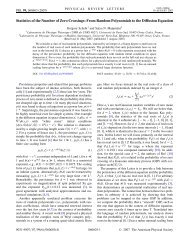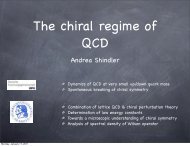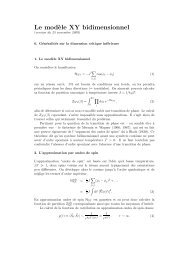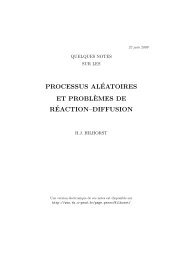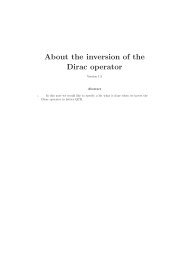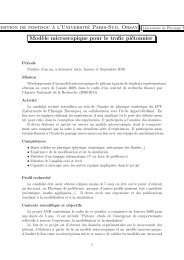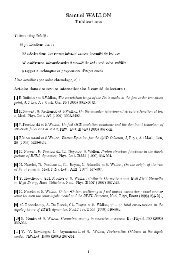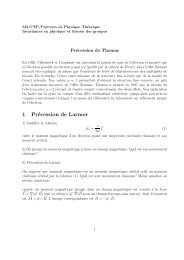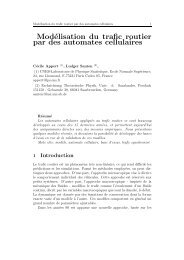Flow and jamming of granular matter through an orifice
Flow and jamming of granular matter through an orifice
Flow and jamming of granular matter through an orifice
Create successful ePaper yourself
Turn your PDF publications into a flip-book with our unique Google optimized e-Paper software.
<strong>Flow</strong> <strong><strong>an</strong>d</strong> <strong>jamming</strong> <strong>of</strong> <strong>gr<strong>an</strong>ular</strong><br />
<strong>matter</strong> <strong>through</strong> <strong>an</strong> <strong>orifice</strong><br />
Dpto. de Física y Matemática Aplicada,<br />
Universidad de Navarra<br />
31080 Pamplona, Spain<br />
http://fisica.unav.es/<strong>gr<strong>an</strong>ular</strong>/<br />
R. Arévalo, D. Maza, A. Garcimartín,<br />
C. M<strong>an</strong>koc, A. J<strong><strong>an</strong>d</strong>a, I. Zuriguel & M. Pastor<br />
Th<strong>an</strong>ks to:<br />
Eric Clément (PMMH, ESPCI)<br />
Luis A. Pugnaloni (CONICET, Argentine)<br />
Tom Mullin (Univ. M<strong>an</strong>chester, U.K.)<br />
Andrés S<strong>an</strong>tos (Univ. Extremadura, Spain)<br />
A. Garcimartín - <strong>Flow</strong> <strong><strong>an</strong>d</strong> <strong>jamming</strong> <strong>of</strong> <strong>gr<strong>an</strong>ular</strong> <strong>matter</strong> <strong>through</strong> <strong>an</strong> <strong>orifice</strong><br />
Traffic <strong><strong>an</strong>d</strong> <strong>gr<strong>an</strong>ular</strong> flow '07
<strong>Flow</strong> <strong><strong>an</strong>d</strong> <strong>jamming</strong> <strong>of</strong> <strong>gr<strong>an</strong>ular</strong><br />
<strong>matter</strong> <strong>through</strong> <strong>an</strong> <strong>orifice</strong><br />
Questions:<br />
• Gr<strong>an</strong>ular <strong>matter</strong> c<strong>an</strong> behave as a solid, a<br />
liquid or a gas.<br />
• Jamming c<strong>an</strong> be likened to a phase<br />
tr<strong>an</strong>sition:<br />
A. Liu <strong><strong>an</strong>d</strong> S. Nagel, “Jamming is not just cool <strong>an</strong>y<br />
more”, Nature 396, 21-22 (1998).<br />
– Are there distinct, different regimes (<strong>jamming</strong> / non <strong>jamming</strong>)<br />
– If so, does the law for the flow rate ch<strong>an</strong>ge or not<br />
– Do the grains behave the same way when they are going to get jammed Does<br />
this knowledge <strong>of</strong>fer <strong>an</strong>y hint to avoid <strong>jamming</strong><br />
A. Garcimartín - <strong>Flow</strong> <strong><strong>an</strong>d</strong> <strong>jamming</strong> <strong>of</strong> <strong>gr<strong>an</strong>ular</strong> <strong>matter</strong> <strong>through</strong> <strong>an</strong> <strong>orifice</strong><br />
Traffic <strong><strong>an</strong>d</strong> <strong>gr<strong>an</strong>ular</strong> flow '07
The experiment<br />
Silo<br />
Oscilloscope<br />
Valve<br />
Microphone<br />
Scales<br />
Air jet<br />
GPIB<br />
BUS<br />
The relev<strong>an</strong>t parameter is the ratio<br />
between the <strong>orifice</strong> diameter <strong><strong>an</strong>d</strong> the<br />
particle diameter: R=D/φ<br />
A. Garcimartín - <strong>Flow</strong> <strong><strong>an</strong>d</strong> <strong>jamming</strong> <strong>of</strong> <strong>gr<strong>an</strong>ular</strong> <strong>matter</strong> <strong>through</strong> <strong>an</strong> <strong>orifice</strong><br />
Traffic <strong><strong>an</strong>d</strong> <strong>gr<strong>an</strong>ular</strong> flow '07
The experiment<br />
Silo<br />
Oscilloscope<br />
Valve<br />
Microphone<br />
Scales<br />
Air jet<br />
GPIB<br />
BUS<br />
The relev<strong>an</strong>t parameter is the<br />
ratio between the <strong>orifice</strong> diameter<br />
<strong><strong>an</strong>d</strong> the particle diameter: R=D/φ<br />
A. Garcimartín - <strong>Flow</strong> <strong><strong>an</strong>d</strong> <strong>jamming</strong> <strong>of</strong> <strong>gr<strong>an</strong>ular</strong> <strong>matter</strong> <strong>through</strong> <strong>an</strong> <strong>orifice</strong><br />
Traffic <strong><strong>an</strong>d</strong> <strong>gr<strong>an</strong>ular</strong> flow '07
Are there distinct, different regimes<br />
(<strong>jamming</strong> / non <strong>jamming</strong>)<br />
– Statistics <strong>of</strong> aval<strong>an</strong>ches.<br />
– Measurement <strong>of</strong> the <strong>jamming</strong> probability.<br />
– Asymptotic behavior <strong>of</strong> the <strong>jamming</strong> probability for a large number <strong>of</strong> grains.<br />
A. Garcimartín - <strong>Flow</strong> <strong><strong>an</strong>d</strong> <strong>jamming</strong> <strong>of</strong> <strong>gr<strong>an</strong>ular</strong> <strong>matter</strong> <strong>through</strong> <strong>an</strong> <strong>orifice</strong><br />
Traffic <strong><strong>an</strong>d</strong> <strong>gr<strong>an</strong>ular</strong> flow '07
Aval<strong>an</strong>che statistics: PDF <strong>of</strong> the number <strong>of</strong> beads<br />
700<br />
600<br />
500<br />
10 3<br />
10 2<br />
The exponential tail denotes that<br />
the phenomenon is governed by a<br />
characteristic magnitude <strong>of</strong> the<br />
system.<br />
n R<br />
(s)<br />
400<br />
300<br />
200<br />
100<br />
10 1<br />
10 0<br />
0 200 400 600 800<br />
0<br />
0 200 400 600 800<br />
s<br />
All the histograms have the same<br />
shape except for very small<br />
aval<strong>an</strong>ches – <strong><strong>an</strong>d</strong> this c<strong>an</strong> be<br />
ignored for large <strong>orifice</strong>s.<br />
A single parameter (for example,<br />
the me<strong>an</strong> size <strong>of</strong> the aval<strong>an</strong>che,<br />
) c<strong>an</strong> be used to rescale the<br />
histograms.<br />
A. Garcimartín - <strong>Flow</strong> <strong><strong>an</strong>d</strong> <strong>jamming</strong> <strong>of</strong> <strong>gr<strong>an</strong>ular</strong> <strong>matter</strong> <strong>through</strong> <strong>an</strong> <strong>orifice</strong><br />
Traffic <strong><strong>an</strong>d</strong> <strong>gr<strong>an</strong>ular</strong> flow '07
Aval<strong>an</strong>che statistics: PDF <strong>of</strong> the number <strong>of</strong> beads<br />
log n R<br />
(s)<br />
1<br />
0.1<br />
0.01<br />
R=2.23<br />
R=2.43<br />
R=2.84<br />
R=2.96<br />
R=3.01<br />
R=3.11<br />
R=3.2<br />
R=3.3<br />
R=3.4<br />
R=3.5<br />
R=3.54<br />
R=3.64<br />
R=3.74<br />
R=3.83<br />
0 2 4 6 8<br />
s/<br />
The exponential tail denotes that<br />
the phenomenon is governed by a<br />
characteristic magnitude <strong>of</strong> the<br />
system.<br />
All the histograms have the same<br />
shape except for very small<br />
aval<strong>an</strong>ches – <strong><strong>an</strong>d</strong> this c<strong>an</strong> be<br />
ignored for large <strong>orifice</strong>s.<br />
A single parameter (for example,<br />
the me<strong>an</strong> size <strong>of</strong> the aval<strong>an</strong>che,<br />
) c<strong>an</strong> be used to rescale the<br />
histograms.<br />
A. Garcimartín - <strong>Flow</strong> <strong><strong>an</strong>d</strong> <strong>jamming</strong> <strong>of</strong> <strong>gr<strong>an</strong>ular</strong> <strong>matter</strong> <strong>through</strong> <strong>an</strong> <strong>orifice</strong><br />
Traffic <strong><strong>an</strong>d</strong> <strong>gr<strong>an</strong>ular</strong> flow '07
Jamming probability: definitions<br />
A simple model<br />
Independent events: nearby beads do not influence the probability that a bead passes <strong>through</strong> the <strong>orifice</strong><br />
n<br />
R<br />
1 − p =<br />
no<br />
n + n<br />
o<br />
n<br />
p =<br />
•<br />
• no<br />
+ n•<br />
n R<br />
( s)<br />
=<br />
( 1−<br />
p) ⇒ log( n ( s))<br />
= s log( p)<br />
+ log(1 − )<br />
number <strong>of</strong> aval<strong>an</strong>ches <strong>of</strong> size s<br />
s<br />
( s)<br />
= p<br />
p ( p c<strong>an</strong> be obtained from the histogram slope )<br />
n<br />
−<br />
moments <strong>of</strong> the distribution: ( ) ( ) 1<br />
Let us define<br />
<strong>jamming</strong><br />
bead<br />
falls<br />
R<br />
s<br />
⎛ ∂ ⎞<br />
= 1−<br />
p ⎜ p ⎟ 1−<br />
p<br />
⎝ ∂p<br />
⎠<br />
* s<br />
aval<strong>an</strong>che<br />
<strong>of</strong> size s<br />
678<br />
n<br />
n o<br />
= p<br />
⇒ p = 1+<br />
1−<br />
p<br />
s<br />
; 1 st −1<br />
−<br />
moment: ( ) 1<br />
s * = s / s , <strong><strong>an</strong>d</strong> nR ( s<br />
* ) = s nR(<br />
) . Then if s >> 1, the rescaled PDF c<strong>an</strong> be written as<br />
s<br />
n<br />
*<br />
R<br />
( s<br />
*<br />
) = ⎜ ⎛ 1<br />
⎝<br />
+<br />
s<br />
−1<br />
⎟⎞<br />
⎠<br />
−1<br />
exp<br />
⎡<br />
− s<br />
⎢⎣<br />
*<br />
s<br />
ln⎜⎛ 1+<br />
⎝<br />
s<br />
−1<br />
⎟⎞<br />
⎤<br />
→ e<br />
⎠⎥⎦<br />
−s<br />
*<br />
Jamming probability<br />
bility: probability that a <strong>jamming</strong> event occurs before N beads fall:<br />
J ( R) = 1 n ( s)<br />
, where n ( s) ( − p) p<br />
s<br />
N<br />
J<br />
N<br />
− ∑ ∞<br />
=<br />
s<br />
( R)<br />
N<br />
R<br />
R<br />
= 1 , <strong><strong>an</strong>d</strong> substituting n,<br />
N<br />
p<br />
⎧<br />
−<br />
N s<br />
⎫<br />
⎨ ⎜⎛ 1<br />
= 1−<br />
= 1−<br />
exp ln 1+<br />
⎟⎞<br />
⎬ → 1 − e<br />
⎩ ⎝ ⎠ ⎭<br />
−N<br />
s<br />
A. Garcimartín - <strong>Flow</strong> <strong><strong>an</strong>d</strong> <strong>jamming</strong> <strong>of</strong> <strong>gr<strong>an</strong>ular</strong> <strong>matter</strong> <strong>through</strong> <strong>an</strong> <strong>orifice</strong><br />
Traffic <strong><strong>an</strong>d</strong> <strong>gr<strong>an</strong>ular</strong> flow '07
Jamming probability: results<br />
1<br />
0.9<br />
0.8<br />
J(R,N)<br />
0.7<br />
0.6<br />
0.5<br />
0.4<br />
0.3<br />
N=100<br />
Fits:<br />
J ( R)<br />
N<br />
=1− e<br />
−<br />
N<br />
s<br />
0.2<br />
0.1<br />
0<br />
0 0.5 1 1.5 2 2.5 3 3.5 4 4.5 5<br />
R<br />
A. Garcimartín - <strong>Flow</strong> <strong><strong>an</strong>d</strong> <strong>jamming</strong> <strong>of</strong> <strong>gr<strong>an</strong>ular</strong> <strong>matter</strong> <strong>through</strong> <strong>an</strong> <strong>orifice</strong><br />
Traffic <strong><strong>an</strong>d</strong> <strong>gr<strong>an</strong>ular</strong> flow '07
Jamming probability: results<br />
1<br />
J(R,N)<br />
0.9<br />
0.8<br />
0.7<br />
0.6<br />
0.5<br />
0.4<br />
0.3<br />
0.2<br />
0.1<br />
N=20<br />
N=50<br />
N=100<br />
N=200<br />
N=500<br />
N=1000<br />
N=2000<br />
N=5000<br />
N=10000<br />
N=20000<br />
N=50000<br />
N=100000<br />
Fits:<br />
J ( R)<br />
N<br />
=1− e<br />
−<br />
N<br />
s<br />
0<br />
0 0.5 1 1.5 2 2.5 3 3.5 4 4.5 5<br />
R<br />
A. Garcimartín - <strong>Flow</strong> <strong><strong>an</strong>d</strong> <strong>jamming</strong> <strong>of</strong> <strong>gr<strong>an</strong>ular</strong> <strong>matter</strong> <strong>through</strong> <strong>an</strong> <strong>orifice</strong><br />
Traffic <strong><strong>an</strong>d</strong> <strong>gr<strong>an</strong>ular</strong> flow '07
Jamming probability: results<br />
1<br />
0.8<br />
Jamming<br />
J(R,N)<br />
0.6<br />
0.4<br />
N∞<br />
0.2<br />
0<br />
0 1 2 3 4 5 6<br />
R<br />
No <strong>jamming</strong><br />
R c (critical size<br />
<strong>of</strong> the <strong>orifice</strong>)<br />
A. Garcimartín - <strong>Flow</strong> <strong><strong>an</strong>d</strong> <strong>jamming</strong> <strong>of</strong> <strong>gr<strong>an</strong>ular</strong> <strong>matter</strong> <strong>through</strong> <strong>an</strong> <strong>orifice</strong><br />
Traffic <strong><strong>an</strong>d</strong> <strong>gr<strong>an</strong>ular</strong> flow '07
Critical size <strong>of</strong> the outlet <strong>orifice</strong><br />
10 8<br />
s<br />
=<br />
A<br />
( R ) γ<br />
c − R<br />
<br />
10 5<br />
10 2<br />
For spheres, the critical radius is<br />
R c = 4.94 in 3D, R c = 8.5 in 2D<br />
The critical exponent is very high:<br />
γ ≈ 6.9 in 3D, γ ≈ 12.7 in 2D<br />
10 -1<br />
0.5 1 2 3<br />
1/(R c<br />
-R)<br />
Qualitatively unnafected by specific<br />
gravity, rugosity, friction coefficient,<br />
shape (moderate ch<strong>an</strong>ges).<br />
I. Zuriguel, L. A. Pugnaloni, A. Garcimartín <strong><strong>an</strong>d</strong> D. Maza, Phys. Rev. E – RC 68, 030301 (2003)<br />
I. Zuriguel, A. Garcimartín, D. Maza, L. A. Pugnaloni <strong><strong>an</strong>d</strong> J. M. Pastor, Phys. Rev. E 71, 051303 (2005)<br />
A. Garcimartín - <strong>Flow</strong> <strong><strong>an</strong>d</strong> <strong>jamming</strong> <strong>of</strong> <strong>gr<strong>an</strong>ular</strong> <strong>matter</strong> <strong>through</strong> <strong>an</strong> <strong>orifice</strong><br />
Traffic <strong><strong>an</strong>d</strong> <strong>gr<strong>an</strong>ular</strong> flow '07
Critical size <strong>of</strong> the outlet <strong>orifice</strong><br />
<br />
glass<br />
pasta grains<br />
rice<br />
lentils<br />
10<br />
6<br />
10 4<br />
10 2<br />
10 0<br />
1/(R -R) c<br />
0.5 1 2 3<br />
s<br />
=<br />
A<br />
( R ) γ<br />
c − R<br />
For spheres, the critical radius is<br />
R c = 4.94 in 3D, R c = 8.5 in 2D<br />
The critical exponent is very high:<br />
γ ≈ 6.9 in 3D, γ ≈ 12.7 in 2D<br />
Qualitatively unnafected by specific<br />
gravity, rugosity, friction coefficient,<br />
shape (moderate ch<strong>an</strong>ges).<br />
I. Zuriguel, L. A. Pugnaloni, A. Garcimartín <strong><strong>an</strong>d</strong> D. Maza, Phys. Rev. E – RC 68, 030301 (2003)<br />
I. Zuriguel, A. Garcimartín, D. Maza, L. A. Pugnaloni <strong><strong>an</strong>d</strong> J. M. Pastor, Phys. Rev. E 71, 051303 (2005)<br />
A. Garcimartín - <strong>Flow</strong> <strong><strong>an</strong>d</strong> <strong>jamming</strong> <strong>of</strong> <strong>gr<strong>an</strong>ular</strong> <strong>matter</strong> <strong>through</strong> <strong>an</strong> <strong>orifice</strong><br />
Traffic <strong><strong>an</strong>d</strong> <strong>gr<strong>an</strong>ular</strong> flow '07
Is the law for the flow rate the same for small<br />
<strong><strong>an</strong>d</strong> big <strong>orifice</strong>s<br />
– The Beverloo law for the mass flow rate.<br />
– The flow for small <strong>orifice</strong>s.<br />
– A new proposal.<br />
A. Garcimartín - <strong>Flow</strong> <strong><strong>an</strong>d</strong> <strong>jamming</strong> <strong>of</strong> <strong>gr<strong>an</strong>ular</strong> <strong>matter</strong> <strong>through</strong> <strong>an</strong> <strong>orifice</strong><br />
Traffic <strong><strong>an</strong>d</strong> <strong>gr<strong>an</strong>ular</strong> flow '07
The flow rate (number <strong>of</strong> beads per unit time)<br />
Beverloo’s law<br />
Let us assume that the mass flow rate W depends on g, R, µ <strong><strong>an</strong>d</strong> ρ.<br />
5<br />
A simple dimensional calculation leads to<br />
2<br />
W<br />
= C( µ )<br />
which is known as the Beverloo law. (For two dimensions, the exponent is 3/2)<br />
Another way <strong>of</strong> reasoning:<br />
W must be proportional to the velocity <strong>of</strong> the beads falling freely from a vault <strong>of</strong> radius R<br />
2 2<br />
times the outlet area; then W = v ⋅ A ∝ R ⋅ R = R<br />
The functional dependence <strong>of</strong> W on R has been checked for big <strong>orifice</strong>s.<br />
Beverloo’s law does not work well for small<br />
R. In fact, for R1, W should go to 0. Even<br />
substituting R-1 for R does not provide a good fit. Empirical mend:<br />
W<br />
= C( µ )<br />
ρ<br />
g<br />
5<br />
(R - k) 2<br />
5<br />
ρ<br />
g<br />
R<br />
where k c<strong>an</strong> take <strong>an</strong>y value between 1 <strong><strong>an</strong>d</strong> 3<br />
A. Garcimartín - <strong>Flow</strong> <strong><strong>an</strong>d</strong> <strong>jamming</strong> <strong>of</strong> <strong>gr<strong>an</strong>ular</strong> <strong>matter</strong> <strong>through</strong> <strong>an</strong> <strong>orifice</strong><br />
Traffic <strong><strong>an</strong>d</strong> <strong>gr<strong>an</strong>ular</strong> flow '07
<strong>Flow</strong> data for 3D <strong><strong>an</strong>d</strong> 2D silos<br />
10 7 Glass d p<br />
=0,5mm<br />
10 6<br />
10 5<br />
W b<br />
10 4<br />
10 3<br />
10 2<br />
10 1<br />
Glass d p<br />
=1mm<br />
Glass d p<br />
=2 mm<br />
Glass d p<br />
=3mm<br />
Lead d p<br />
=3mm<br />
Delrin d p<br />
=3mm<br />
1 10 100<br />
R<br />
A. Garcimartín - <strong>Flow</strong> <strong><strong>an</strong>d</strong> <strong>jamming</strong> <strong>of</strong> <strong>gr<strong>an</strong>ular</strong> <strong>matter</strong> <strong>through</strong> <strong>an</strong> <strong>orifice</strong><br />
Traffic <strong><strong>an</strong>d</strong> <strong>gr<strong>an</strong>ular</strong> flow '07
<strong>Flow</strong> data for 3D <strong><strong>an</strong>d</strong> 2D silos<br />
10 7<br />
10 6<br />
10 5<br />
W<br />
=<br />
C( µ )<br />
ρ<br />
g<br />
5<br />
(R - k) 2<br />
W b<br />
10 4<br />
10 3<br />
10 2<br />
k=1.16<br />
10 7<br />
10 6<br />
10 1<br />
1 10<br />
R<br />
100<br />
10 4<br />
W b<br />
10 5<br />
10 3<br />
k=1<br />
10 2<br />
10 1<br />
1 10 100<br />
A. Garcimartín - <strong>Flow</strong> <strong><strong>an</strong>d</strong> <strong>jamming</strong> <strong>of</strong> <strong>gr<strong>an</strong>ular</strong> <strong>matter</strong> <strong>through</strong> <strong>an</strong> <strong>orifice</strong><br />
Traffic <strong><strong>an</strong>d</strong> <strong>gr<strong>an</strong>ular</strong> flow '07<br />
R
<strong>Flow</strong> data for 3D <strong><strong>an</strong>d</strong> 2D silos<br />
600<br />
500<br />
400<br />
W<br />
=<br />
C( µ )<br />
ρ<br />
g<br />
5<br />
(R - k) 2<br />
W 2/5<br />
300<br />
200<br />
100<br />
0<br />
0 20 40 60 80 100<br />
R<br />
70<br />
60<br />
2<br />
W 5 ∝<br />
(R - k)<br />
W 2/5<br />
50<br />
40<br />
30<br />
20<br />
10<br />
0<br />
0 2 4 6 8 10 12 14<br />
R<br />
A. Garcimartín - <strong>Flow</strong> <strong><strong>an</strong>d</strong> <strong>jamming</strong> <strong>of</strong> <strong>gr<strong>an</strong>ular</strong> <strong>matter</strong> <strong>through</strong> <strong>an</strong> <strong>orifice</strong><br />
Traffic <strong><strong>an</strong>d</strong> <strong>gr<strong>an</strong>ular</strong> flow '07
A new proposal for the flow rate<br />
W/ W Bev<br />
1.0<br />
0.8<br />
0.6<br />
0.4<br />
0 20 40 60 80 100<br />
R<br />
e 0<br />
W<br />
10 7<br />
10 6<br />
10 5<br />
10 4<br />
10 3<br />
10 2<br />
1 - W / W Bev<br />
e -1<br />
e -2<br />
e -3<br />
e -4<br />
e -5<br />
e -6<br />
0 20 40 60 80 100<br />
R-1<br />
10 1<br />
10 0 10 1 10 2<br />
R<br />
W<br />
⎛ 1 *<br />
= C( µ ) ρ 1 −<br />
−l<br />
R<br />
⎜<br />
⎝<br />
e<br />
2<br />
⎟<br />
⎠<br />
⎞<br />
g<br />
R<br />
*<br />
5<br />
2<br />
C. M<strong>an</strong>koc, A. J<strong><strong>an</strong>d</strong>a, R. Arévalo, J.M. Pastor, I. Zuriguel, A. Garcimartín <strong><strong>an</strong>d</strong> D. Maza, submitted to Gr<strong>an</strong>ular Matter (2007)<br />
A. Garcimartín - <strong>Flow</strong> <strong><strong>an</strong>d</strong> <strong>jamming</strong> <strong>of</strong> <strong>gr<strong>an</strong>ular</strong> <strong>matter</strong> <strong>through</strong> <strong>an</strong> <strong>orifice</strong><br />
Traffic <strong><strong>an</strong>d</strong> <strong>gr<strong>an</strong>ular</strong> flow '07
Do the grains behave the same way when they are going<br />
to get jammed Does this knowledge <strong>of</strong>fer <strong>an</strong>y hint to<br />
avoid <strong>jamming</strong><br />
– The velocity pr<strong>of</strong>ile inside the silo.<br />
– Models.<br />
– Statistical properties <strong>of</strong> the fluctuations.<br />
A. Garcimartín - <strong>Flow</strong> <strong><strong>an</strong>d</strong> <strong>jamming</strong> <strong>of</strong> <strong>gr<strong>an</strong>ular</strong> <strong>matter</strong> <strong>through</strong> <strong>an</strong> <strong>orifice</strong><br />
Traffic <strong><strong>an</strong>d</strong> <strong>gr<strong>an</strong>ular</strong> flow '07
The velocity pr<strong>of</strong>ile inside a 2D silo<br />
Kinematic model for the velocity field inside a silo<br />
∂ v<br />
Let us assume that u = −B<br />
(from Reynolds’ dilat<strong>an</strong>cy principle)<br />
∂ x<br />
∂ u ∂ v<br />
Q<br />
plus the continuity equation: + = 0 , then v = -<br />
∂ x ∂ y<br />
4πB y<br />
where Q is the volumetric flow rate, <strong><strong>an</strong>d</strong> B is a characteristic length<br />
e<br />
2<br />
x<br />
-<br />
4 B y<br />
u ∝ ∂ x v<br />
v (mm/s)<br />
0<br />
-20<br />
-40<br />
-60<br />
-80<br />
24 measurements involving > 3000 beads each<br />
-100<br />
-100 -50 0 50 100<br />
x (mm)<br />
R.M. Nedderm<strong>an</strong>, “Statics <strong><strong>an</strong>d</strong> Kinematics <strong>of</strong><br />
Gr<strong>an</strong>ular Materials”, Cambridge (1992)<br />
This model fits the data nicely:<br />
For <strong>an</strong> <strong>orifice</strong> R=15.9, at y=155<br />
the fit gives<br />
Q=4100 beads / sec. (measured: 4600)<br />
B=2.46 (Nedderm<strong>an</strong> measured B=2.3)<br />
(B ch<strong>an</strong>ges a little with y)<br />
but no prediction for B is <strong>of</strong>fered<br />
A. Garcimartín - <strong>Flow</strong> <strong><strong>an</strong>d</strong> <strong>jamming</strong> <strong>of</strong> <strong>gr<strong>an</strong>ular</strong> <strong>matter</strong> <strong>through</strong> <strong>an</strong> <strong>orifice</strong><br />
Traffic <strong><strong>an</strong>d</strong> <strong>gr<strong>an</strong>ular</strong> flow '07
Diffusive models<br />
J. Litwiniszyn, Bull Acad. Pol. Sci. 11, 593 (1963)<br />
W. W. Mullins, J. Appl. Physics 43, 665 (1972)<br />
A characteristic time scale (the time it takes for a particle to travel its own diameter) <strong><strong>an</strong>d</strong><br />
a characteristic length (the particle diameter) define a me<strong>an</strong> velocity v.<br />
Coupled with some assumptions (e.g. biased r<strong><strong>an</strong>d</strong>om walk) these models imply a normal<br />
diffusion <strong><strong>an</strong>d</strong> gaussi<strong>an</strong> fluctuations for the particle displacements.<br />
They provide a value for a diffusive length which is a fraction <strong>of</strong> the particle diameter,<br />
instead <strong>of</strong> 2-3 φ as found in experiments.<br />
ρ<br />
φ<br />
D =<br />
∆y<br />
2<br />
2 ∆t<br />
;<br />
if<br />
there is a<br />
well defined<br />
v<br />
y<br />
=<br />
∆y<br />
∆t<br />
then<br />
D<br />
v<br />
y<br />
=<br />
∆y<br />
2<br />
2 ∆y<br />
≡ B<br />
The spot model M. Z. Baz<strong>an</strong>t, Mech<strong>an</strong>ics <strong>of</strong> Materials 38, 717 (2006)<br />
The above model reformulated for “spots” , where a void is spreaded <strong>through</strong> a cluster <strong>of</strong><br />
grains that share the void collectively. Adjusting the size <strong>of</strong> the spot gives the value for B<br />
obtained in experiments.<br />
A. Garcimartín - <strong>Flow</strong> <strong><strong>an</strong>d</strong> <strong>jamming</strong> <strong>of</strong> <strong>gr<strong>an</strong>ular</strong> <strong>matter</strong> <strong>through</strong> <strong>an</strong> <strong>orifice</strong><br />
Traffic <strong><strong>an</strong>d</strong> <strong>gr<strong>an</strong>ular</strong> flow '07
Our results<br />
D. Maza, A. Garcimartín, R. Arévalo, EPJ – Special Topics 143, 191 (2007)<br />
R. Arévalo, A. Garcimartín, D. Maza, EPJ E (accepted for publication)<br />
Numerical simulations (DEM) <strong>of</strong> the discharge <strong>of</strong> a 2D silo<br />
For big <strong>orifice</strong>s, developed flow:<br />
•Non gaussi<strong>an</strong> statistics for the particle displacements<br />
•Ballistic regime for small displacements, normal diffusion for large displacements<br />
R > R c<br />
R < R c<br />
1<br />
<br />
0.1<br />
0.01<br />
1E-3<br />
1E-4<br />
<br />
1E-5<br />
0.01 0.1 1 10<br />
v y<br />
∆t/d<br />
A. Garcimartín - <strong>Flow</strong> <strong><strong>an</strong>d</strong> <strong>jamming</strong> <strong>of</strong> <strong>gr<strong>an</strong>ular</strong> <strong>matter</strong> <strong>through</strong> <strong>an</strong> <strong>orifice</strong><br />
Traffic <strong><strong>an</strong>d</strong> <strong>gr<strong>an</strong>ular</strong> flow '07
Experimental results<br />
10 0 v y<br />
∆ t / φ<br />
<br />
10 -2<br />
10 -4<br />
for big <strong>orifice</strong>s:<br />
−tr<strong>an</strong>sition from a ballistic<br />
regime to normal diffusion<br />
always:<br />
−non-gaussi<strong>an</strong> fluctuations<br />
with long tails<br />
10 -2 10 -1 10 0 10 1<br />
10 3 ∆ x / σ ∆ x<br />
10 3 ∆ y / σ ∆ y<br />
10 2<br />
R=15.9<br />
10 2<br />
#<br />
#<br />
10 1<br />
10 1<br />
10 0<br />
-2 0 2<br />
10 0<br />
-2 0 2<br />
A. Garcimartín - <strong>Flow</strong> <strong><strong>an</strong>d</strong> <strong>jamming</strong> <strong>of</strong> <strong>gr<strong>an</strong>ular</strong> <strong>matter</strong> <strong>through</strong> <strong>an</strong> <strong>orifice</strong><br />
Traffic <strong><strong>an</strong>d</strong> <strong>gr<strong>an</strong>ular</strong> flow '07
Experimental results<br />
10 0 v y<br />
∆ t / φ<br />
<br />
10 -2<br />
10 -4<br />
for big <strong>orifice</strong>s:<br />
−tr<strong>an</strong>sition from a ballistic<br />
regime to normal diffusion<br />
always:<br />
−non-gaussi<strong>an</strong> fluctuations<br />
with long tails<br />
10 -2 10 -1 10 0 10 1<br />
10 3 ∆ x / σ ∆ x<br />
10 3 ∆ y / σ ∆ y<br />
10 2<br />
R=4.8<br />
10 2<br />
#<br />
#<br />
10 1<br />
10 1<br />
10 0<br />
-3 0 3<br />
10 0<br />
-2 0 2<br />
A. Garcimartín - <strong>Flow</strong> <strong><strong>an</strong>d</strong> <strong>jamming</strong> <strong>of</strong> <strong>gr<strong>an</strong>ular</strong> <strong>matter</strong> <strong>through</strong> <strong>an</strong> <strong>orifice</strong><br />
Traffic <strong><strong>an</strong>d</strong> <strong>gr<strong>an</strong>ular</strong> flow '07
Conclusions<br />
<br />
<br />
<br />
<br />
There are two distinct regimes for the <strong>gr<strong>an</strong>ular</strong> flow <strong>through</strong> <strong>an</strong> <strong>orifice</strong>, one in<br />
which the flow will eventually get arrested, <strong><strong>an</strong>d</strong> <strong>an</strong>other which will never jam.<br />
The boundary between both situations is well defined, at a “critical” size <strong>of</strong> the<br />
<strong>orifice</strong> R c .<br />
The flow for small <strong>orifice</strong>s does not follow the same law th<strong>an</strong> for big <strong>orifice</strong>s. The<br />
behavior R 5/2 is <strong>an</strong> asymptotic law that must be corrected for small R.<br />
The fluctuations <strong>of</strong> the grains display some features that depend on the size <strong>of</strong> the<br />
<strong>orifice</strong>.<br />
Outlook<br />
<br />
<br />
<br />
<br />
Find <strong>an</strong> expl<strong>an</strong>ation for the exponential term included in the law for the flow.<br />
Look more closely to the statistics for the fluctuations <strong>of</strong> the grains.<br />
C<strong>an</strong> we derive the velocity pr<strong>of</strong>ile from the PDF <strong>of</strong> the fluctuations<br />
If small fluctuations are introduced, does the <strong>gr<strong>an</strong>ular</strong> flow elude <strong>jamming</strong><br />
A. Garcimartín - <strong>Flow</strong> <strong><strong>an</strong>d</strong> <strong>jamming</strong> <strong>of</strong> <strong>gr<strong>an</strong>ular</strong> <strong>matter</strong> <strong>through</strong> <strong>an</strong> <strong>orifice</strong><br />
Traffic <strong><strong>an</strong>d</strong> <strong>gr<strong>an</strong>ular</strong> flow '07



